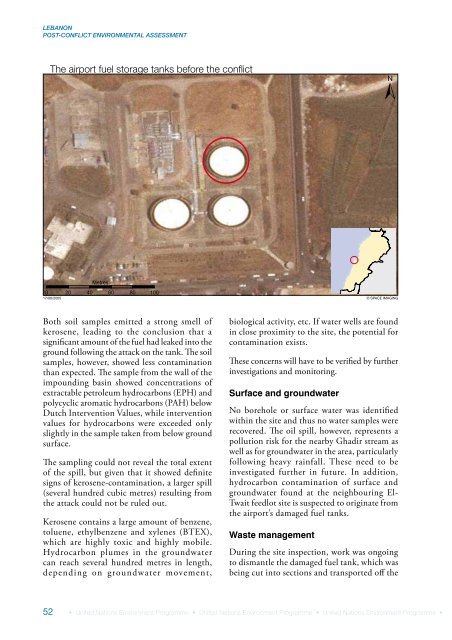Lebanon Post-Conflict Environmental Assessment - UNEP
Lebanon Post-Conflict Environmental Assessment - UNEP
Lebanon Post-Conflict Environmental Assessment - UNEP
Create successful ePaper yourself
Turn your PDF publications into a flip-book with our unique Google optimized e-Paper software.
LEBANONPOST-CONFLICT ENVIRONMENTAL ASSESSMENTThe airport fuel storage tanks before the conflictMetres0 20 40 60 80 10017/06/2005 © SPACE IMAGINGBoth soil samples emitted a strong smell ofkerosene, leading to the conclusion that asignificant amount of the fuel had leaked into theground following the attack on the tank. The soilsamples, however, showed less contaminationthan expected. The sample from the wall of theimpounding basin showed concentrations ofextractable petroleum hydrocarbons (EPH) andpolycyclic aromatic hydrocarbons (PAH) belowDutch Intervention Values, while interventionvalues for hydrocarbons were exceeded onlyslightly in the sample taken from below groundsurface.The sampling could not reveal the total extentof the spill, but given that it showed definitesigns of kerosene-contamination, a larger spill(several hundred cubic metres) resulting fromthe attack could not be ruled out.Kerosene contains a large amount of benzene,toluene, ethylbenzene and xylenes (BTEX),which are highly toxic and highly mobile.Hydrocarbon plumes in the groundwatercan reach several hundred metres in length,depending on groundwater movement,biological activity, etc. If water wells are foundin close proximity to the site, the potential forcontamination exists.These concerns will have to be verified by furtherinvestigations and monitoring.Surface and groundwaterNo borehole or surface water was identifiedwithin the site and thus no water samples wererecovered. The oil spill, however, represents apollution risk for the nearby Ghadir stream aswell as for groundwater in the area, particularlyfollowing heavy rainfall. These need to beinvestigated further in future. In addition,hydrocarbon contamination of surface andgroundwater found at the neighbouring El-Twait feedlot site is suspected to originate fromthe airport’s damaged fuel tanks.Waste managementDuring the site inspection, work was ongoingto dismantle the damaged fuel tank, which wasbeing cut into sections and transported off the52 • United Nations Environment Programme • United Nations Environment Programme • United Nations Environment Programme •
















